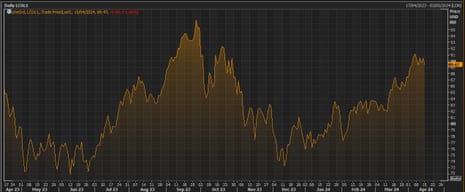Oil is continuing to drop this morning, with Brent crude down 1% today at $89.52 per barrel.
Having risen last week in anticipation that Iran would respond to the bombing of its diplomatic complex in Syria two weeks ago, oil is now retreating on relief that the damage was not worse.
AJ Bell investment director Russ Mould says:
The situation remains fraught and, beyond the geopolitical and humanitarian implications, a more widespread conflict in the Middle East could see energy prices surge and unpick central banks’ careful efforts to bring down inflation.
Key events
Back in the markets, the oil price is sliding further into the red.
Brent crude is now down 1.6% at $88.96 per barrel, as traders cling to hopes that tensions in the Middle East will not escalate further following Iran’s retaliatory strike on Israel last weekend.
Some senior names at Tesla have also left the company.
That include Andrew Baglino, Tesla’s senior vice president for powertrain and energy engineering. Baglino has posted that he made the difficult decision to leave yesterday – which suggests he’s chosen to quit, rather than seeing his role axed.
Baglino writes:
When I joined as a junior firmware / electrical engineer back in 2006, a future Tesla that produced the world’s top selling vehicle was well beyond my expected set of outcomes. A reminder to all of us to set higher expectations, I guess :)
I made the difficult decision to move on from Tesla after 18 years yesterday. I am so thankful to have worked with and learned from the countless incredibly talented people at Tesla over the years.
I loved tackling nearly 🤣 every problem we solved as a team and feel gratified…
Bloomberg’s Ed Ludlow reports that Rohan Patel, Tesla’s senior global director of public policy and business development, has also left.
Tesla’s plans to cut 10% of its workforce haven’t given its share price a lift.
Shares in Tesla have dropped by 3.5% in early trading to $165.05, down from $171.05 on Friday night.
That knocks $19bn off its market capitalisation so far today, down from $544bn to $525bn.
So far this year, Tesla has now lost a third of its value.
Wall Street opens in the green
The US stock market has begun the new week with gains, as traders in New York shrug off Iran’s attack on Israel last weekend.
The Dow Jones industrial average has risen by 353 points, or 0.9%, to 38,336 points, recovering a lot of Friday’s fall.
The broader S&P 500 has gained 0.7%, and the tech-focused Nasdaq is up 0.6%.
Analysts at BNY Mellon say the markets are in a “risk on” mood, as the “worst-case fears about Iran and Israel have not materialized”, meaning investors are now unwinding hedges they took out last week.
As explained this morning, there’s relief in the markets that most of the missiles and drones fired by Iran towards Israel were shot down.
Hopes that tensions won’t escalate are rising, after the White House has warned Israel that the US will not participate in any retaliatory strikes on Iran.
Back in the City, the FTSE 100 share index has shrugged off its earlier losses.
The blue-chip share index is now up 5 points, or 0.07%, which pushes it back over the 8,000-point mark.
That means its less than 50 points away from the record high of 8,047 points, which could come back into play if market nervousness recedes….
The US retail sales report will “further support” the Federal Reserve’s stance that there is no rush to start lowering interest rates, reports Andrew Hunter, deputy chief US economist at Capital Economics.
Hunter told clients:
Although growth over the first quarter as a whole was hit by the weather-related weakness in January, the March gain leaves retail spending growth looking in better shape than the data previously implied.
And although overall real consumption growth still looks to have slowed from the 3.3% annualised gain seen in the fourth quarter of last year, it was still apparently more than 2.5% annualised. Alongside the recent resurgence in employment growth, the continued resilience of consumption is another reason to suspect the Fed will wait longer before starting to cut interest rates, which now we think won’t happen until September.
Let's get this straight:
NFP rock solid
ISM pretty solid
CPI way too high
Retail sales strong
Why are we talking about ''multiple'' rate cuts? Stop it!
Today’s strong retail sales suggest the US economy is holding up well, which may deter the Federal Reserve from cutting interest rates soon.
The US dollar has strengthened since the better-than-expected US retail sales were announced, hitting its highest level since last November.
This has pushed the Japanese yen down to a new 34-year low, at 154.28 yen to the dollar, which will intensify the pressure on Tokyo to intervene and support its currency.
US retail sales beat forecasts
Just in: US retail sales were stronger than expected last month, as the American economy continues to show resilience.
Retail sales rose by 0.7% month-on-month in March, and were 4% higher than in March 2023, the US Census bureau reports.
Spending at nonstore retailers (ie online shops) was up 11.3% year-on-year, while takings at food services and drinking places were 6.5% higher than in March 2023.
General merchandise stores grew their sales by 5.7%, while miscellaneous store sales jumped 6.1%, suggesting that consumer spending remained robust.
But, sales at furniture and home furnishings shops fell 6.1% year-on-year; perhaps due to the drop in home sales towards the end of last year.
Retail sales in the US surged in March, rising 0.7% month-over-month! 📈 Major boosts in:
Nonstore retailers: 2.7%
Gasoline stations: 2.1%
Miscellaneous store retailers: 2.1%
Building material & garden equipment: 0.7%$SPY $QQQ $NVDA $TSLA $ASML pic.twitter.com/Y0KLUbylys
Goldman Sachs beats forecasts with 28% jump in profits

Goldman Sachs has beaten expectations by posting a 28% jump in profits for the first quarter of this year.
Goldman has reported it made net earnings of $4.13bn for the January-March quarter, up from $3.23.bn a year ago.
That lifted its earnings per share to $11.58, up almost a third from $8.79 in the first quarter of last year.
Goldman reported “strong performances” in earnings from investment banking fees, from its Fixed Income, Currency and Commodities arm, and from its Equities division.
Goldman CEO David Solomon says:
“Our first quarter results reflect the strength of our world-class and interconnected franchises and the earnings power of Goldman Sachs. We continue to execute on our strategy, focusing on our core strengths to serve our clients and deliver for our shareholders.”
Goldman’s investment bankers had a busier year, with fees up 32% to $2.08bn. This was driven by higher revenues from debt underwriting, to fund leveraged finance activity (using debt to buy assets).
Energy giant BP is also cutting jobs at its electric vehicle charging arm.
Reuters reports that BP has cut over a tenth of positions at its EV charging business, BP Pulse, and also withdrawn from several markets.
It is now focusing on the US, the UK, Germany and China – four countries where it sees the fastest EV growth – and pulled out of several other markets. This means around 100 jobs were axed; most staff affected have been redeployed, with just a handful leaving BP.
$TSLA | EV maker Tesla reportedly issued an email on Monday to all employees announcing LAYOFFs of 10% of its global staff, affecting more than 14,000 employees.
Check out Elon memo about this 👇
CEO Musk said, “As we prepare the company for our next phase of growth, it is… pic.twitter.com/73kolOUtmM
Shares in Tesla are down 0.7% in pre-market trading, as traders digest reports that it will cut 10% of its staff in a cost-cutting drive.
They fell 2% on Friday, and are down around 31% so far this year.
Tesla 'laying off 10% of workforce'
Electric carmaker Tesla is reportedly planning to lay off more than 10% of its workforce, as it battles rising competition and softer demand.
Technology publication Electrek reported this morning that Tesla staff had been told, in a company-wide email, that one in ten employees are being cut.
According to Electrek, Musk broke the news to staff, saying:
Over the years, we have grown rapidly with multiple factories scaling around the globe. With this rapid growth there has been duplication of roles and job functions in certain areas. As we prepare the company for our next phase of growth, it is extremely important to look at every aspect of the company for cost reductions and increasing productivity.
As part of this effort, we have done a thorough review of the organization and made the difficult decision to reduce our headcount by more than 10% globally. There is nothing I hate more, but it must be done. This will enable us to be lean, innovative and hungry for the next growth phase cycle.
Musk then thanked those who are leaving Tesla for their hard work, adding “It is very difficult to say goodbye.”
At the end of last year, Tesla had over 140,000 employees, which suggests at least 14,000 jobs are to go.
Earlier this month Tesla reported its first quarterly fall in deliveries in nearly four years, partly due to disruption at its Fremont factory in California as it tries to increase production of the updated Model 3.
Tesla is due to report its next financial results after Wall Street closes on Tuesday, April 23, covering the first three months of this year.
Three months ago, it missed forecasts for revenues and earnings for the final quarter of 2023.
India’s stock market has hit its lowest level since the end of last month, as geopolitical tensions weighed on shares.
The Sensex index lost 1.1% in today’s nervous trading, amid a rise in volatility.
#MarketAtClose | Market ends at a 2-week closing low amid geopolitical tensions
Frontline indices slip more than 1% with broader markets falling more
Market fails to hold intra-day recovery, ends at day’s low
Most sectoral indices slip while volatility index rises 8% pic.twitter.com/pPfwC1pSIn

Larry Elliott
Newsflash: The devastating impact of the Covid-19 pandemic on the world’s poorest countries has brought poverty reduction to a halt and led to a widening income gap with nations in the rich west, the World Bank has warned.
In a report released to coincide with its half-yearly meeting, the Washington-based organisation said half of the world’s 75 poorest nations had seen income per head rise more slowly than in developed countries over the past five years.
Urging governments and the private sector to do more to help tackle what it called a “great reversal”, the Bank said that since 2019 there had been a surge in food insecurity and debt distress.
The Bank’s data showed that one in three countries eligible for grants and concessional loans under its International Development Association (IDA) arm was poorer, on average, than it was on the eve of the Covid-19 pandemic. Not since the last five years of the 20th century had more than half of the poorest countries experienced income per head grow more slowly than in developed countries.
Although oil is down this morning, it’s only dipped to its lowest level since last Wednesday.
That suggests that some, but not all, of the risk premium in the oil price has dissipated, with Brent crude down $1 per barrel at $89.50.

Raffi Boyadjian, lead investment analyst at XM, says:
It seems that the immediate market reaction to Iran’s onslaught of missiles is relief, as the attacks were well telegraphed in advance, giving the Israelis and Americans plenty of time to prepare for defensive action. Even oil futures barely flinched, spiking modestly higher at Monday’s open before pulling lower.
Elsewhere this morning, industrial production across the eurozone has crept up, but was sharply lower than a year ago.
Industrial production increased by 0.8% in the euro area in February data from Eurostat shows, compared with January.
But on an annual basis, industrial output was 6.4% lower than in February 2023 across the euro area.
This annual decline was partly due to a 3.6% drop in energy output, but was also driven by a near 9% decline in production of capital goods (heavy-duty machinery).
Oil is continuing to drop this morning, with Brent crude down 1% today at $89.52 per barrel.
Having risen last week in anticipation that Iran would respond to the bombing of its diplomatic complex in Syria two weeks ago, oil is now retreating on relief that the damage was not worse.
AJ Bell investment director Russ Mould says:
The situation remains fraught and, beyond the geopolitical and humanitarian implications, a more widespread conflict in the Middle East could see energy prices surge and unpick central banks’ careful efforts to bring down inflation.
Goldman: oil prices already reflect a $5-10/bbl risk premium
Goldman Sachs analysts estimate that the oil price currently includes a risk premium of between $5 and $10 per barrel, to reflect risks to supplies from geopolitical shocks.
In a research note this morning, Goldman explain that the Brent crude price (at around $90/barrel this morning) is around $10/barrel higher than predicted by a model assuming no new disruptions to oil supply.
They say:
While the geopolitical risk premium—the compensation investors demand for the risk that geopolitical shocks reduce oil supply—is difficult to estimate, our rough estimate informed by our pricing framework and the cost of hedging would be around $5-10/bbl.
The cost of insuring against oil price spikes has picked up following attacks on Russian refineries and rising Iran-Israel tensions but has remained less elevated as of Friday than in October 2023 and in 2022 because Middle East crude production remains unaffected by the war.
Goldman add that they are focused on several potential risks:
OPEC+ may extend the existing production cuts further in a context of increased tensions between the West and several key OPEC+ countries.
The Middle East or Russia-Ukraine conflicts may damage upstream, midstream, or downstream oil infrastructure (as has happened to Russian refineries).
Iranian oil supply may decline on disruptions or under a potentially more hawkish US Administration.
While still highly unlikely, we estimate that an interruption of oil flows through the Strait of Hormuz, through which currently 17% of global oil production flows, would lead oil prices to rise 20% in the first month and eventually double if the interruption persisted for several months. Iran’s seizure of a cargo ship near the Strait of Hormuz may keep some focus on the risks to that shipping lane.

.png)









